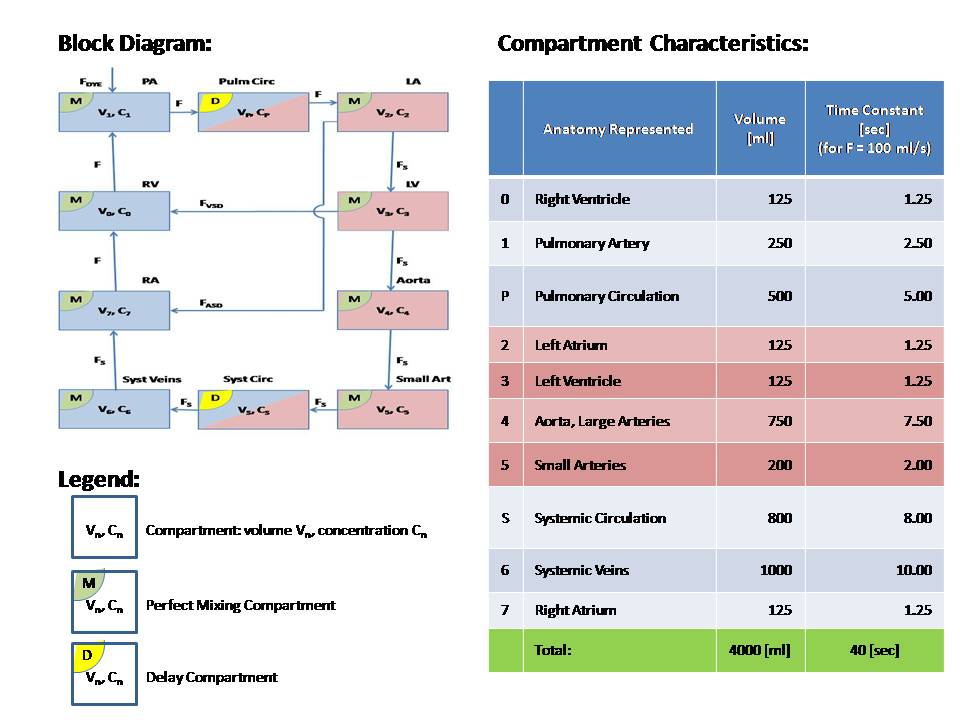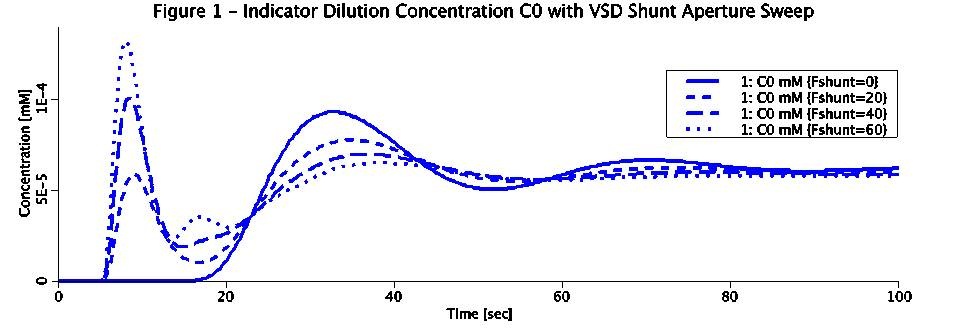Compartmental cardiovascular indicator dilution model based on Rideout_IndicatorDilution with systemic flow used as constant reference. Also in MATLAB.
Description


This model simulates the human cardiovascular loop. It can simulate a healthy or deseased heart. Both Ventricular Septal Defect (VSD) and Atrial Septal Defect (ASD) are modeled. To simulate a healthy heart, set both shunt flows Fvsd and Fasd to zero. To investigate a deseased heart set either or both to a positive flow. Unlike Rideout's original model (Rideout_IndicatorDilution), this model keeps the systemic flow (Fs) as constant reference. This is more analogous to real life and is needed to keep us alive. When the systemic flow Fs is held constant, intracardiac flows must rise when there is a shunt, and observations of pulmonary hypertension and heart failure are easy to understand. The model is made of 10 compartments which combine perfect mixing and delay compartments. The anatomy represented by each compartment, as well as its volume and time constant are shown in the table above. This is a simple model which ignores capillary diffusion. An indicator bolus is injected into the pulmonary artery (compartment 1) and recirculates through the compartments. By conservation of mass, the total amount of indicator in all compartments is fixed. In a healthy heart there are no internal loops. Blood flows from compartment to compartment in series. We expect to see the concentration peak in each compartment with the accumulated delays as shown in the table. The Transport Time around the loop is 40 sec. We expect all compartments to show a peak-to-peak delay of ~40 sec (as long as the second peak can be distinguished). Indicator concentrations eventually flatten into a unified concentration in all compartments. In a diseased heart, there is an additional inner loop which flows in parallel to the outer loop and disrupts normal function. Ventricular Septal Defect (VSD) includes a shunt from the left ventricle (compartment 3) to the right ventricle (compartment 0). Atrial Septal Defect (ASD) includes a shunt from the left atrium (compartment 2) to the right atrium (compartment 7). Figure 1 shows indicator dilution C0 when the VSD shunt aperture is swept from 0 to 60 ml/s, which is 60% of the default systemic reference flow (100 ml/s). Note that in VSD, an early peak in the right ventricle is visible and increases in amplitude as the shunt aperture is increased. ASD creates a similar effect, where indicator dilution C7 shows an early peak.
Equations
The equations for this model may be viewed by running the JSim model applet and clicking on the Source tab at the bottom left of JSim's Run Time graphical user interface. The equations are written in JSim's Mathematical Modeling Language (MML). See the Introduction to MML and the MML Reference Manual. Additional documentation for MML can be found by using the search option at the Physiome home page.
- Download JSim model MML code (text):
- Download translated SBML version of model (if available):
Download MATLAB model M-file
We welcome comments and feedback for this model. Please use the button below to send comments:
Rideout VC. Mathematical computer modeling of physiological systems. Prentice Hall, Englewood Cliffs, NJ, 1991, Section 3.4, pp. 43-57; and problems 3.3 and 3.4 pp. 65-66
Please cite https://www.imagwiki.nibib.nih.gov/physiome in any publication for which this software is used and send one reprint to the address given below:
The National Simulation Resource, Director J. B. Bassingthwaighte, Department of Bioengineering, University of Washington, Seattle WA 98195-5061.
Model development and archiving support at https://www.imagwiki.nibib.nih.gov/physiome provided by the following grants: NIH U01HL122199 Analyzing the Cardiac Power Grid, 09/15/2015 - 05/31/2020, NIH/NIBIB BE08407 Software Integration, JSim and SBW 6/1/09-5/31/13; NIH/NHLBI T15 HL88516-01 Modeling for Heart, Lung and Blood: From Cell to Organ, 4/1/07-3/31/11; NSF BES-0506477 Adaptive Multi-Scale Model Simulation, 8/15/05-7/31/08; NIH/NHLBI R01 HL073598 Core 3: 3D Imaging and Computer Modeling of the Respiratory Tract, 9/1/04-8/31/09; as well as prior support from NIH/NCRR P41 RR01243 Simulation Resource in Circulatory Mass Transport and Exchange, 12/1/1980-11/30/01 and NIH/NIBIB R01 EB001973 JSim: A Simulation Analysis Platform, 3/1/02-2/28/07.

